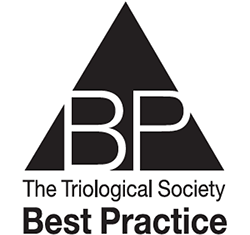Explore This Issue
August 2024TRIO Best Practice articles are brief, structured reviews designed to provide the busy clinician with a handy outline and reference for day-to-day clinical decision making. The ENTtoday summaries below include the Background and Best Practice sections of the original article. To view the complete Laryngoscope articles free of charge, visit Laryngoscope.com.
BACKGROUND
Tonsillectomy is one of the most frequently performed operations in the U.S.; the most common surgical indications include sleep-disordered breathing, obstructive sleep apnea, and recurrent tonsillitis. Intracapsular tonsillectomy (also known as intracapsular tonsillotomy, partial tonsillectomy, or subtotal tonsillectomy) was first introduced in 1910 but has recently gained more popularity. Intracapsular tonsillectomy is performed by removing the tonsillar tissue down to the level of the tonsillar capsule. This is typically performed with either a coblator (Smith and Nephew) or microdebrider (Medtronic), but can also be performed with cold steel, harmonic, laser, or bipolar electrocautery.
Intracapsular tonsillectomy is not yet included in the clinical practice guidelines and is not widely performed nationwide. One of the greatest barriers to adopting this technique is concern for tonsillar regrowth; many surgeons cite this possibility as their main reason for not adopting it. Additional obstacles include the learning curve associated with mastering a new tonsillectomy technique and concerns for increased intra-operative blood loss with microdebrider intracapsular tonsillectomy. Others are hesitant to offer intracapsular tonsillectomy in chronic or recurrent tonsillitis, with the thought that if the entirety of the tonsil is not removed, these symptoms could recur.
A recent meta-analysis showed that patients who underwent intracapsular tonsillectomy had lower absolute pain scores and a faster return to normal diet and activity levels compared with those who underwent extracapsular tonsillectomy. Numerous short- and long-term studies support the benefits of intracapsular tonsillectomy, but there is a paucity of information regarding its efficacy in special populations, such as syndromic patients.
BEST PRACTICE
 Intracapsular tonsillectomy has multiple benefits, including decreased post-operative hemorrhage rate and faster resolution of pain. Most of the available data have demonstrated the benefits of intracapsular tonsillectomy in pediatric patients with sleep-disordered breathing, but this method is effective for obstructive sleep apnea and recurrent tonsillitis as well. Long-term complications such as tonsillar regrowth are higher than extracapsular tonsillectomy, but still rare. Many studies show that the benefits of intracapsular tonsillectomy outweigh this risk. Intracapsular tonsillectomy is a safe and effective method for performing tonsillectomy and should be included in future clinical practice guidelines for tonsillectomy. Further prospective studies reviewing outcomes in syndromic patients will help confirm its efficacy in these populations.
Intracapsular tonsillectomy has multiple benefits, including decreased post-operative hemorrhage rate and faster resolution of pain. Most of the available data have demonstrated the benefits of intracapsular tonsillectomy in pediatric patients with sleep-disordered breathing, but this method is effective for obstructive sleep apnea and recurrent tonsillitis as well. Long-term complications such as tonsillar regrowth are higher than extracapsular tonsillectomy, but still rare. Many studies show that the benefits of intracapsular tonsillectomy outweigh this risk. Intracapsular tonsillectomy is a safe and effective method for performing tonsillectomy and should be included in future clinical practice guidelines for tonsillectomy. Further prospective studies reviewing outcomes in syndromic patients will help confirm its efficacy in these populations.
